Golden Perch & Live Sonar
Lubin Pfeiffer takes a look at the latest echo sounder technology, and how it can be used to improve your catch.
There is no doubt live sonar has changed the way anglers fish forever, and particularly those chasing golden perch. The fact that you can see what your lure is doing in real-time gives you a distinct advantage over what you would’ve gained using the traditional sounders. I have found Live Sonar to be an integral part of my kit in some areas, leading to some amazing numbers of fish being caught. In this article I’ll run you through the way I like to use this new technology while targeting golden perch.
A STEEP LEARNING CURVE
The biggest key to getting confidence in live sonar is to commit to using it. I first got live sonar about four years ago, but was reluctant to commit to using it. It does hugely change the way you fish and approach the river, and it also dramatically changes the way you see what is under the water after you’ve spent a lot of time using it. There are no secrets with live sonar, no theories on what and when the fish do; it’s all there for anglers to see in real-time.
In years gone by, winter time would see golden perch fishing “slow down” in the river and the number of fish caught would be far less than during the summer months. It turns out the fish don’t move that far, they just school up in pre-spawn mode ready for the springtime run. Using Live, I have found astonishing amounts of goldens stacked on trees in deeper water along the river. One snag that comes to mind we found during a fishing day this year was well away from the riverbank, so it was pretty hard to find in the first place. The thing with Live is that you can actually see how good a snag is and get a very good look at it. A traditional sounder would’ve picked up that there was something there, but it’s the detail and the ability to see the fish swimming around that is the big difference.
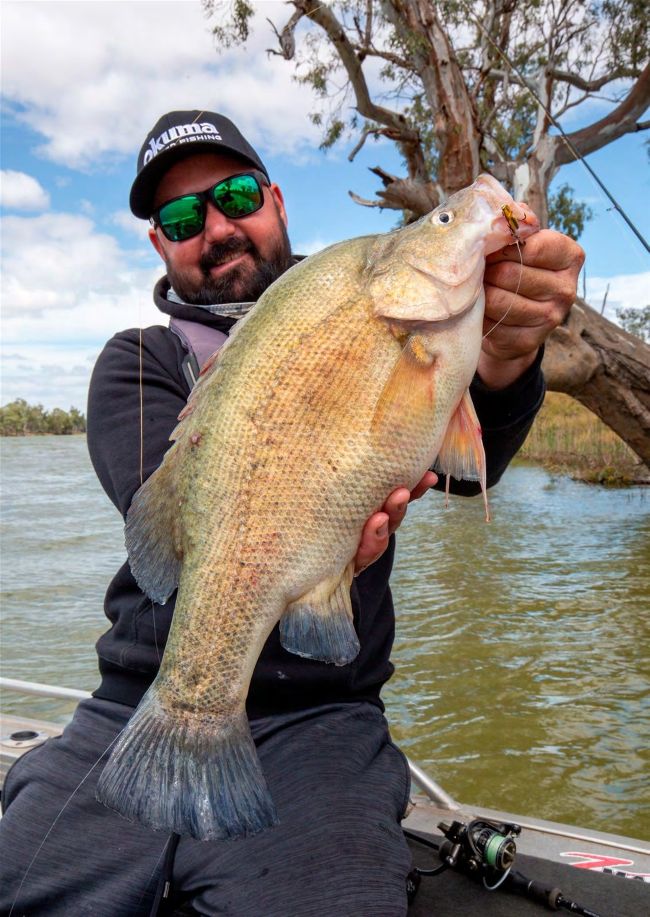
Goldens like this giant make live sonar well worthwhile
This tree was lit up like a Christmas tree covered in lights. The first time we fished it we caught 20 goldens, one after the other, jigging TT switchblades using the Live. The tree was also holding a large number of small bony bream, which the goldens were feeding on. Interestingly, the first 10 or so fish were eager to eat the blade and would move over and inhale them. Once they became a bit cagey, you really had to slow everything down and make way more subtle movements to get them to bite. The ‘shake and bake’ technique fooled quite a few, and even totally stopping the jig when they got near them was also very effective. But without being able to see what was going on in real-time, none of this would’ve been possible.
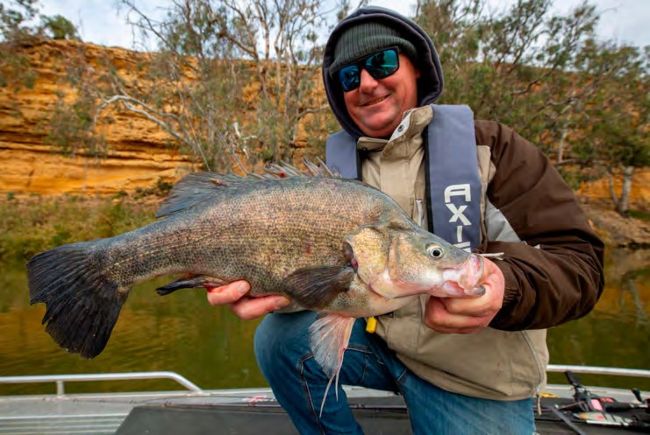
The next time I visited that snag I pulled 16 from it and the third time another 15. Over 50 goldens off a single snag in three visits on lures within a week is just mind-blowing to a younger me. I was always just happy catching one! It’s moments like these that bring the technology together and give you confidence in it.
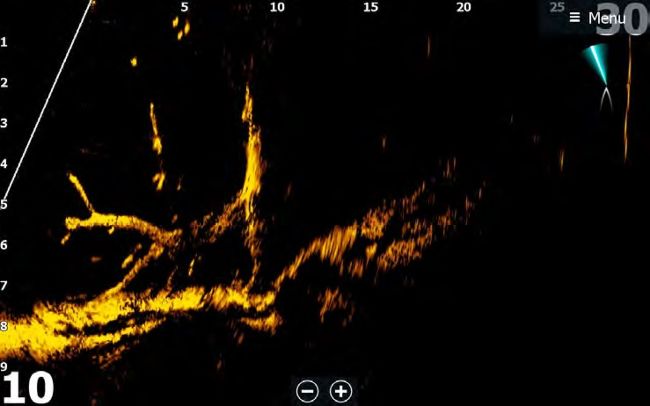
Keeping tabs on your lure via sonar is crucial
It took me at least a couple of years to get to know exactly what it is I’m looking at on the screen, but now feel confident I can tell the difference between goldens,carp and bony bream. This allows you to be able to directly target the fish you want to catch. I’ve been lucky enough to travel Australia using the tech’, and this has definitely helped a huge amount and been able to fish and talk with some amazing anglers who have given me plenty of tips that have led to more success.
GETTING SET UP FOR GOLDENS ON LIVE
If you’re looking to invest in live technology, there are a few things you probably need to know. Firstly, the whole kit is very expensive and, in some cases, will be worth more than the boat, motor and trailer! There are some budget ways you can get around this, but from what I have experienced these can make the technology even harder to use when it is already a lot to take in and understand. I run a HDS12 Pro on the front of my boat and use the AT2 transducer. The transducer is attached to a Transducer Poles Australia carbon fibre pole and Ultra-free Mount. To the end of this where the transducer is attached is a Fish Obsessed Dominator Mount. All this probably sounds like it makes no sense at all, but it is integral for not only getting the best picture from your sonar, but also for making it quick and easy to change modes on your live sonar.
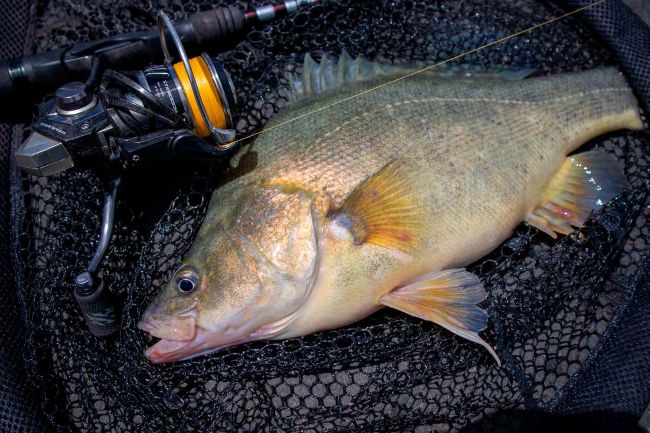

I started with a simple kit, and while it did get the job done in some cases, it is simply not even in the same ballpark as the setup I have now. Looking at the pole firstly, the thinner the pole is, the less water it catches and the easier it is to turn and scan the water with. It also doesn’t ride up easily, which is a huge bonus, as my last pole would always swing up with the pressure of the water, which means you have to go slower and cover less water and in turn, you are not finding as many fish.
The Ultra-Free mount is the most stable way to attach your pole to the RAM mount which is fixed to your boat. The best way this was explained to me, is that you think of it the same way as when you are filming something. If your hand is shaky, or the tripod you have the video camera attached to is wobbly, then the picture you are going to get will be out of focus and not crisp. When everything is super smooth, the picture on your sounder screen will be leaps and bounds better. Seeing this first-hand has totally changed the way I look at the importance of a good mount for your transducer pole. I would have to put Vaseline on my old pole to make it smooth to turn, which was always a pain and never a total solution. The Fish Obsessed Dominator Mount is a clickable mount that allows you to change from the different modes in an instant and is far better than the standard screw clamp that comes with the unit. It is also zero degrees, which means where the pole is facing is exactly where the transducer is facing and what you are seeing on the screen. So, when you cast in line with the pole, you know that’s where the target is and where your lure is going to land.
The biggest key to success with Live Sonar is being able to present the lure so that it appears on the screen and you can see where it is in relation to the fish. Without seeing your lure you won’t catch the fish. It’s that simple. The anglers who are best with Live Sonar have a great ability to be able to present the lure exactly in line with the transducer and that way it appears on the screen instantly. As soon as you have to move the pole to find the lure, the fish may move and you will need to make the cast again. In some cases you won’t get the same shot and may have missed your opportunity.
Being able to quickly change modes on the transducer will mean that you do it more often and find the best mode for the area you are fishing. Usually, I will always start with Forward mode if I’m fishing in water over 3m deep and set it for 10m of depth and a distance of 30m. When jigging an underwater tree like you do for golden perch, it can pay sometimes to click the transducer to ‘down’ mode to get a better picture of the snag. Then go back to Forward mode when moving on to the next spot.
Shallow water is best approached with Scout mode, which is a shallow but wide beam and requires the transducer to be flipped on its side. All of this is quick and easy with the right mount. From my experience, it is easy to become lazy because changing modes with the standard mount is a chore, and unless you really have to, you don’t experiment nearly as much and get the best mode for the area you are fishing. Most areas you find golden perch will have many different water types and being able to change the mode to suit what is best is a big key to success.
LURES FOR LIVE
Probably the thing that Live Sonar does simplify is lure selection. Almost always you will be using a sinking lure such as a blade or spinnerbait. I’ve lost a little faith in crankbaits because they simply don’t go that far down on a cast — 2-3m max. They absolutely still have their place fishing blind or working in shallow areas, but this is not where Live Sonar excels. This is good for anglers though as you can keep your lure selection down and not have to change that much. A big addition I would suggest is to change out the rear treble on your blades and add assets hooks, as these will retain the fish far better than a treble hook. You can see the way a golden will roll around during a fight and this is the way they unhook themselves. Small assist hooks don’t allow this to happen. I’ve been using the pre-rigged TT asset hooks in medium and large, and they have been perfect.
Heading into spring and summer, the golden perch fishing should really heat up, and with the recent explosion of native fish in our rivers, there should be some great fishing to be had throughout the system. I’m looking forward to maybe one day having a couple of our reservoirs open to electric only, as this would open up the under-utilised fishery and create some amazing fishing opportunities when the river is coloured or in flood. One can dream! If you haven’t seen Live Sonar in action, I can definitely recommend jumping on board with someone who has the setup. The things you learn about fisheries and fish behaviour are invaluable, and golden perch are the perfect species to start out on as well.
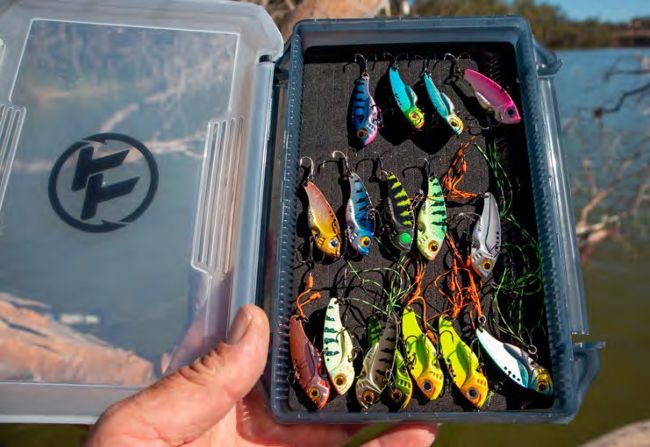
Blades and vibes work well with the live sonar system